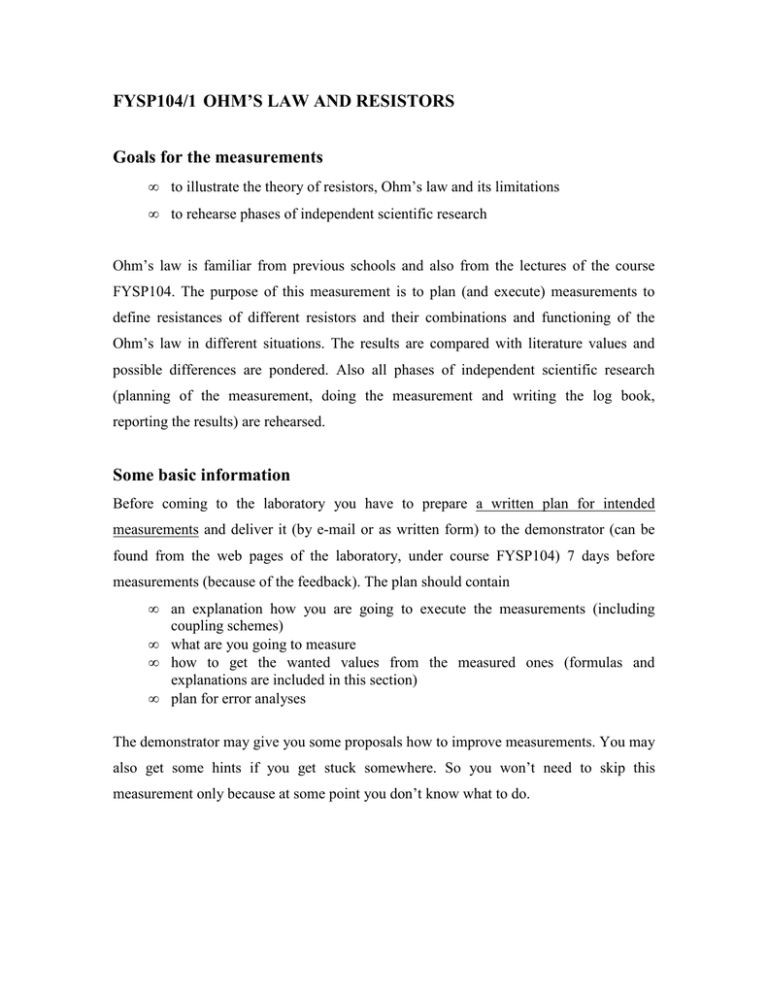FYSP104/1 OHM`S LAW AND RESISTORS Goals for the
advertisement

FYSP104/1 OHM’S LAW AND RESISTORS Goals for the measurements • to illustrate the theory of resistors, Ohm’s law and its limitations • to rehearse phases of independent scientific research Ohm’s law is familiar from previous schools and also from the lectures of the course FYSP104. The purpose of this measurement is to plan (and execute) measurements to define resistances of different resistors and their combinations and functioning of the Ohm’s law in different situations. The results are compared with literature values and possible differences are pondered. Also all phases of independent scientific research (planning of the measurement, doing the measurement and writing the log book, reporting the results) are rehearsed. Some basic information Before coming to the laboratory you have to prepare a written plan for intended measurements and deliver it (by e-mail or as written form) to the demonstrator (can be found from the web pages of the laboratory, under course FYSP104) 7 days before measurements (because of the feedback). The plan should contain • • • • an explanation how you are going to execute the measurements (including coupling schemes) what are you going to measure how to get the wanted values from the measured ones (formulas and explanations are included in this section) plan for error analyses The demonstrator may give you some proposals how to improve measurements. You may also get some hints if you get stuck somewhere. So you won’t need to skip this measurement only because at some point you don’t know what to do. 2 Measurements • Measure the resistance of a small resistor (of the order of ohms) with the following different methods: (i) directly with a general purpose meter (GPM) and on the other hand (ii) based on Ohm’s law measuring current - voltage values so that you measure (iia) the voltage difference over the resistor (short coupling) and (iib) voltage difference over the resistor in series with a current meter (long coupling). What are the reasons for different results? Carry out corresponding measurements for a large resistor (of the order of mega ohms). What happens now? • Using suitable resistors study how well the theory for resistors in serial and parallel couplings is valid. Use at least 2 to 3 different configurations. Measure the resistances with a GPM. Also verify the resistance of each colour coded resistor separately. • Study various measuring methods to verify the of Ohm’s law for copper wires with different dimensions (length and thickness). Present the results using various methods you may know. Compare the resistivity of copper you have deduced to the values in literature. • Study the resistance of a few halogen lamps as a function of the current applied to them. Define the power of the lamps as a function of the current. Conclusions? • Investigate the nominal resistance of a 1.5 volt battery by measuring the pole voltage and current with several external resistors. Select the resistors from the range 100 Ω – 5 Ω, in which case the current supplied by the battery is 10 mA – 100 mA. Use first the larger resistors going step by step to the smaller ones. Show the results graphically and define the electromotive force and nominal resistance of the battery. (A hint: think about what the formulae U = E - RsI presented graphically means.) All the necessary equipments are available in the laboratory. Measurements containing electric circuits are harder than the average, so more hints are given for those. If during the measurements you notice that the preplan was partly incomplete or incorrect, you may do experiments not mentioned in the preplan. This will not influence the rating of 3 your work. On the contrary, well argumented deviation from the preplan shows that you have learned from the work and done it with thought. A proper report is written from the measurements. Laboratory notes (and other attachments) are attached and rated as a part of the report. The demonstrator adds the original preplan to the report and rates it also.







